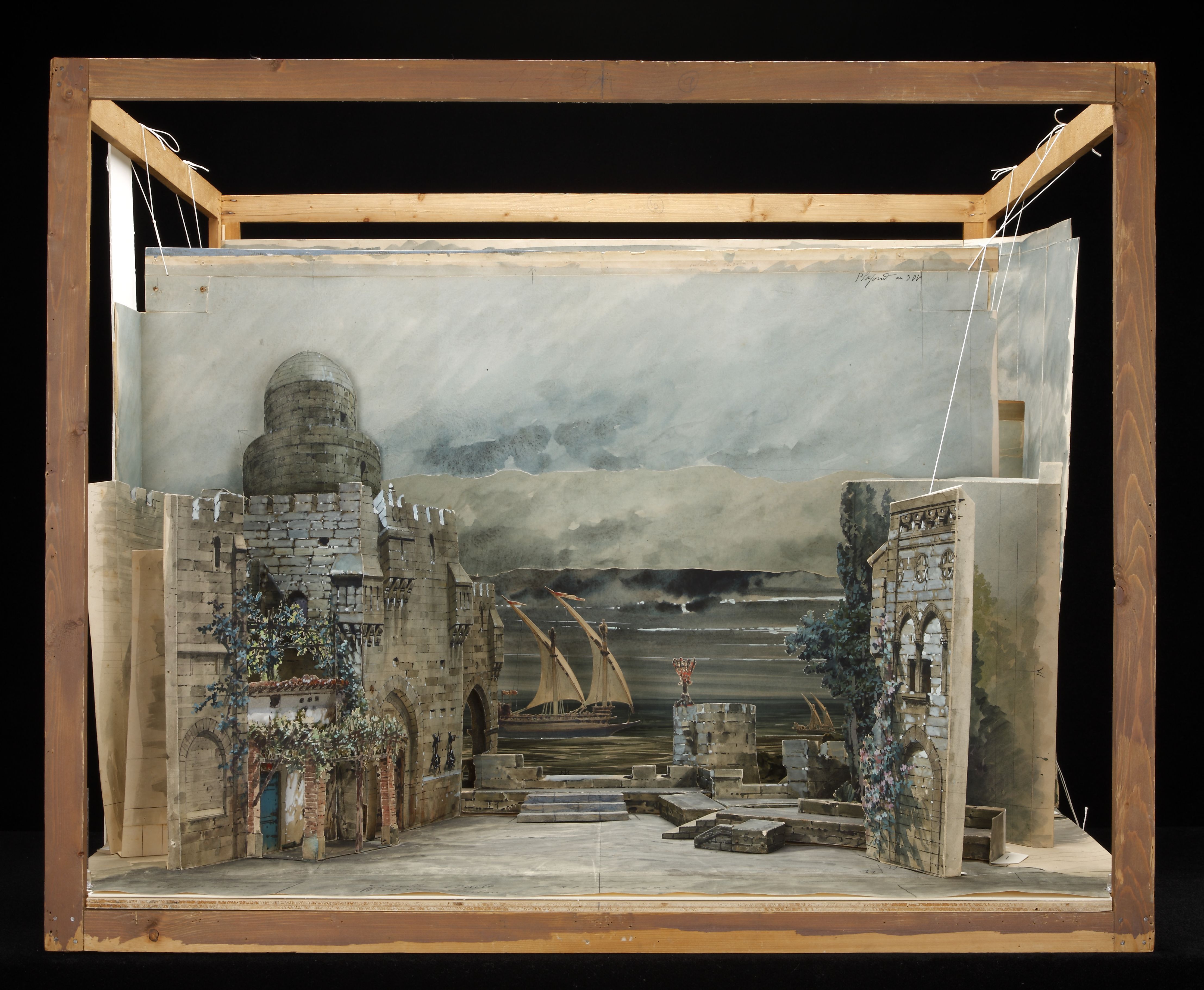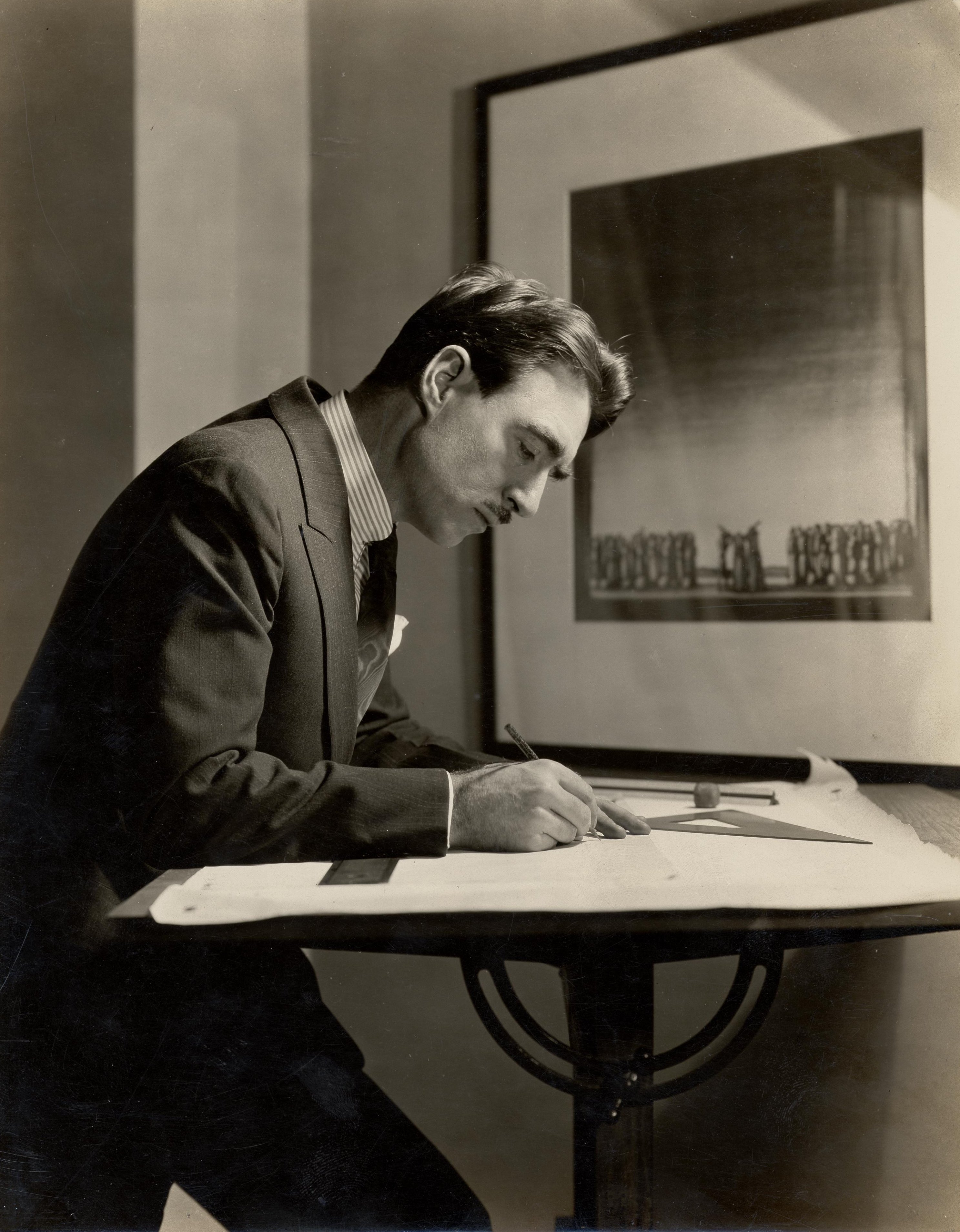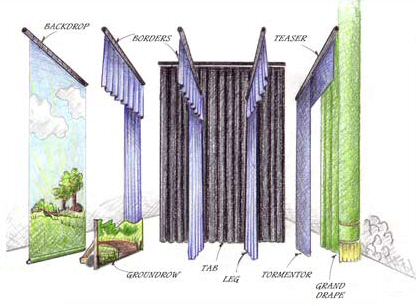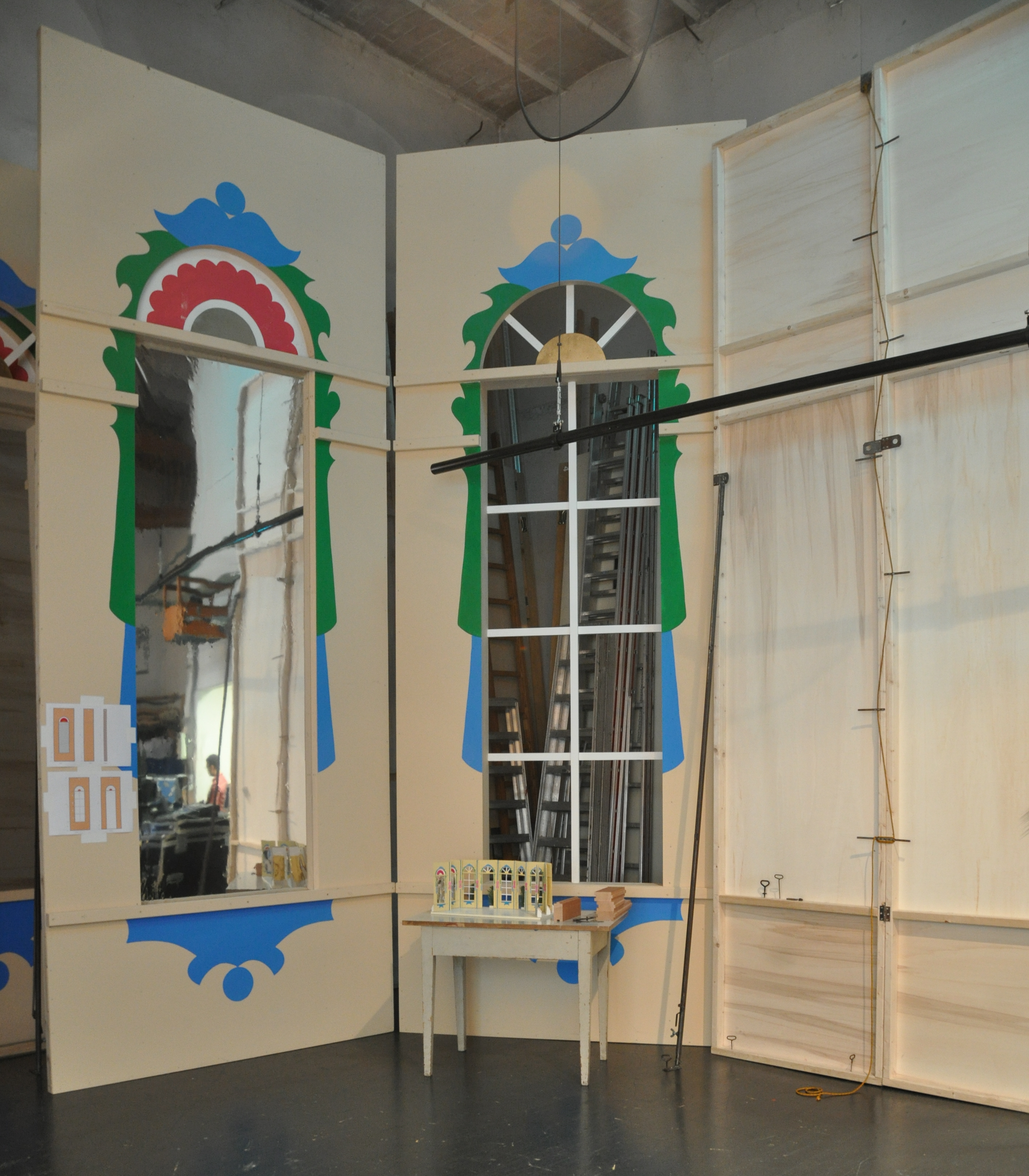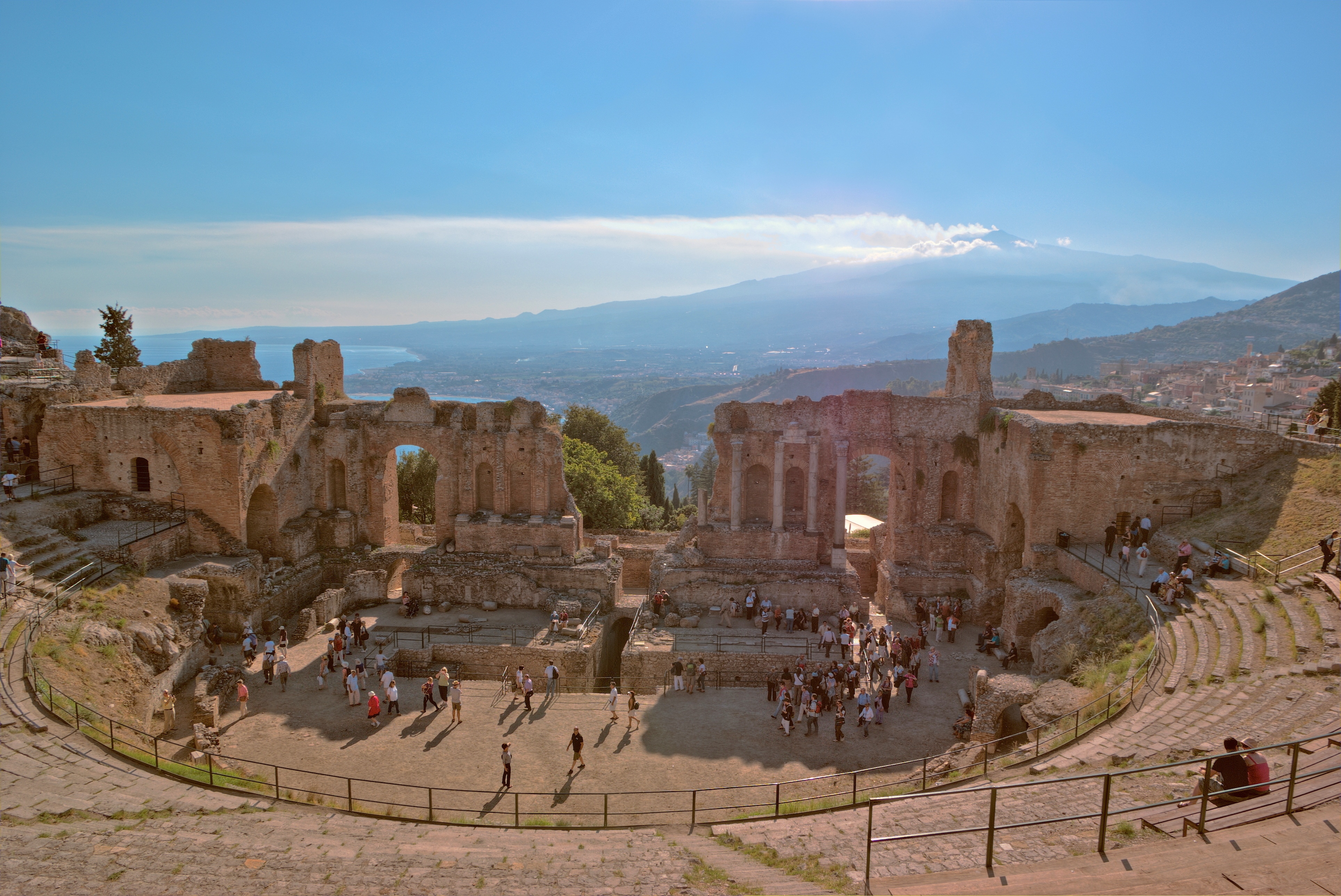|
Scenery
Theatrical scenery is that which is used as a setting for a theatrical production. Scenery may be just about anything, from a single chair to an elaborately re-created street, no matter how large or how small, whether the item was custom-made or is the genuine item, appropriated for theatrical use. History The history of theatrical scenery is as old as the theatre itself, and just as obtuse and tradition bound. What we tend to think of as 'traditional scenery', i.e. two-dimensional canvas-covered ' flats' painted to resemble a three-dimensional surface or vista, is a relatively recent innovation and a significant departure from the more ancient forms of theatrical expression, which tended to rely less on the actual representation of space senerial and more on the conveyance of action and mood. By the Shakespearean era, the occasional painted backdrop or theatrical prop was in evidence, but the show itself was written so as not to rely on such items to convey itself to the audien ... [...More Info...] [...Related Items...] OR: [Wikipedia] [Google] [Baidu] |
Scenery Wagon
A scenery wagon, also known as a ''stage wagon'', is a mobile platform that is used to support and transport movable, three-dimensional theatrical scenery on a theater stage. In most cases, the scenery is constructed on top of the wagon such that the wagon, and the scenery it supports, forms a single, integrated structure. Heavy duty casters are mounted to the underside of the platform so that the entire assembly can be quickly moved onstage or offstage, so as to facilitate rapid scenery changes during live productions. Scenery wagons are built in a wide range of sizes, ranging from less than one square foot up to the size of the playing area of the stage. Scenery wagons comprise one of the four methods used to move scenery during the course of a theatre performance, the other three being "flying" (suspending) scenery from a fly system, elevating or lowering scenery on a stage lift, or "running" (manually carrying) the scenery. Components Casters Various caster types are used ... [...More Info...] [...Related Items...] OR: [Wikipedia] [Google] [Baidu] |
Stagecraft
Stagecraft is a technical aspect of theatrical, film, and video production. It includes constructing and rigging scenery; hanging and focusing of lighting; design and procurement of costumes; make-up; stage management; audio engineering; and procurement of props. Stagecraft is distinct from the wider umbrella term of scenography. Considered a technical rather than an artistic field, it is primarily the practical implementation of a scenic designer's artistic vision. In its most basic form, stagecraft may be executed by a single person (often the stage manager of a smaller production) who arranges all scenery, costumes, lighting, and sound, and organizes the cast. Regional theaters and larger community theaters will generally have a technical director and a complement of designers, each of whom has a direct hand in their respective designs. Within significantly larger productions, for example a modern Broadway show, effectively bringing a show to opening night requires th ... [...More Info...] [...Related Items...] OR: [Wikipedia] [Google] [Baidu] |
Set Construction
Set construction is the process undertaken by a construction manager to build full-scale scenery, as specified by a production designer or art director working in collaboration with the director of a production to create a set for a theatrical, film, or television production. The set designer produces a scale model, scale drawings, paint elevations (a scale painting supplied to the scenic painter of each element that requires painting), and research about props, textures, and so on. Scale drawings typically include a groundplan, elevation, and section of the complete set, as well as more detailed drawings of individual scenic elements which, in theatrical productions, may be static, flown, or built onto scenery wagons. Models and paint elevations are frequently hand-produced, though in recent years, many Production Designers and most commercial theatres have begun producing scale drawings with the aid of computer drafting programs such as AutoCAD or Vectorworks. Theat ... [...More Info...] [...Related Items...] OR: [Wikipedia] [Google] [Baidu] |
Scenic Design
Scenic design (also known as scenography, stage design, or set design) is the creation of theatrical, as well as film or television scenery. Scenic designers come from a variety of artistic backgrounds, but in recent years, are mostly trained professionals, holding B.F.A. or M.F.A. degrees in theatre arts. Scenic designers create sets and scenery that aim to support the overall artistic goals of the production. There has been some consideration that scenic design is also production design; however, it is generally considered to be a part of the visual production of a film or television. Scenic designer The scenic designer works with the director and other designers to establish an overall visual concept for the production and design the stage environment. They are responsible for developing a complete set of design drawings that include the following: *''basic ground plan'' showing all stationary and scenic elements; *''composite ground plan'' showing all moving scenic ... [...More Info...] [...Related Items...] OR: [Wikipedia] [Google] [Baidu] |
Theater Drapes And Stage Curtains
Theater drapes and stage curtains are large pieces of cloth that are designed to mask backstage areas of a theater from spectators. They are designed for a variety of specific purposes, moving in different ways (if at all) and constructed from various fabrics. Many are made from black or other darkly colored, light-absorbing material (In North America, for example, heavyweight velour is the current industry standard). Theater drapes represent a portion of any production's ''soft goods'', a category comprising any non-wardrobe, cloth-based element of the stage or scenery. Theater curtains are often pocketed at the bottom to hold weighty chain or to accept pipes to remove their fullness and stretch them tight. Proscenium stages use a greater variety of drapes than arena or thrust stages. In proscenium theaters, drapes are typically suspended from battens and can be controlled by a fly system (i.e., They are "flown," in theater terminology). When a drape is flown, the task of adjust ... [...More Info...] [...Related Items...] OR: [Wikipedia] [Google] [Baidu] |
Flats (theatre)
A flat (short for scenery flat) or coulisse is a flat piece of theatrical scenery which is painted and positioned on stage so as to give the appearance of buildings or other background. Flats can be soft covered (covered with cloth such as muslin Muslin () is a cotton fabric of plain weave. It is made in a wide range of weights from delicate sheers to coarse sheeting. It gets its name from the city of Mosul, Iraq, where it was first manufactured. Muslin of uncommonly delicate hand ...) or hard covered (covered with decorative plywood such as luan). Soft-covered flats have changed little from their origin in the Italian Renaissance. Flats with a frame that places the width of the lumber parallel to the face are called "Broadway" or "stage" flats. Hard-covered flats with a frame that is perpendicular to the paint surface are referred to as "Hollywood" or "studio" flats. Usually flats are built in standard sizes of , , or tall so that walls or other scenery may easil ... [...More Info...] [...Related Items...] OR: [Wikipedia] [Google] [Baidu] |
Theatre
Theatre or theater is a collaborative form of performing art that uses live performers, usually actors or actresses, to present the experience of a real or imagined event before a live audience in a specific place, often a stage. The performers may communicate this experience to the audience through combinations of gesture, speech, song, music, and dance. Elements of art, such as painted scenery and stagecraft such as lighting are used to enhance the physicality, presence and immediacy of the experience. The specific place of the performance is also named by the word "theatre" as derived from the Ancient Greek θέατρον (théatron, "a place for viewing"), itself from θεάομαι (theáomai, "to see", "to watch", "to observe"). Modern Western theatre comes, in large measure, from the theatre of ancient Greece, from which it borrows technical terminology, classification into genres, and many of its theme (arts), themes, stock characters, and plot elements. Theatre art ... [...More Info...] [...Related Items...] OR: [Wikipedia] [Google] [Baidu] |
Scenography
Scenography (inclusive of scenic design, lighting design, sound design, costume design) is a practice of crafting stage environments or atmospheres. In the contemporary English usage, scenography is the combination of technological and material stagecrafts to represent, enact, and produce a sense of place in performance. While inclusive of the techniques of scenic design and set design, scenography is a holistic approach to the study and practice of all aspects of design in performance. Etymology and cultural interpretations The term scenography is of Greek origin (''skēnē'', meaning 'stage or scene building'; ''grapho'', meaning 'to describe') originally detailed within Aristotle's ''Poetics'' as 'skenographia'. Nevertheless, within continental Europe, the term has been closely aligned with the professional practice of scénographie and is synonymous with the English-language term 'theatre design Scenic design (also known as scenography, stage design, or set design) is ... [...More Info...] [...Related Items...] OR: [Wikipedia] [Google] [Baidu] |
Set (film And TV Scenery)
A set is artificially constructed scenery used in theatre, film and TV. In the latter two cases there are many reasons to build or use a set instead of travelling to a real location, such as budget, time, the need to control the environment, or the fact that the place does not exist. Sets are normally constructed on a film studio backlot or sound stage, but any place that has been modified to give the feel of another place is a set. Gallery New_York_Street-1.jpg, New York Street at the former Columbia Ranch Burbank California Scenografia_di_"Rome"_-_panoramio.jpg, link=File:Scenografia_di_%22Rome%22_-_panoramio.jpg, Ancient Rome set at Cinecittà Studios. Coastal_Command-_the_Production_of_a_Ministry_of_Information_Film_at_Pinewood_Studios,_Iver_Heath,_Buckinghamshire,_England,_UK,_March_1942_D7204.jpg, "''Coastal Command'' " a production set on a soundstage at Pinewood Studios, Iver Heath, Buckinghamshire, March 1942 WorldWarZGlasgowOB&SWATVehicles.jpg, Glasgow city centre ... [...More Info...] [...Related Items...] OR: [Wikipedia] [Google] [Baidu] |
Vaudeville
Vaudeville (; ) is a theatrical genre of variety entertainment born in France at the end of the 19th century. A vaudeville was originally a comedy without psychological or moral intentions, based on a comical situation: a dramatic composition or light poetry, interspersed with songs or ballets. It became popular in the United States and Canada from the early 1880s until the early 1930s, but the idea of vaudeville's theatre changed radically from its French antecedent. In some ways analogous to music hall from Victorian Britain, a typical North American vaudeville performance was made up of a series of separate, unrelated acts grouped together on a common bill. Types of acts have included popular and classical musicians, singers, dancers, comedians, trained animals, magicians, ventriloquists, strongmen, female and male impersonators, acrobats, clowns, illustrated songs, jugglers, one-act plays or scenes from plays, athletes, lecturing celebrities, minstrels, a ... [...More Info...] [...Related Items...] OR: [Wikipedia] [Google] [Baidu] |
Platform (theatre)
In theatre, a platform (also referred to as a riser or rostrum) is a stationary, standard flat walking surface for actors to perform on. Typically, they are built to be assembled modularly. They are often used to provide varying levels, to make a show more visually interesting. They are also used to separate areas on stage, and as seating bleachers. This is in contrast to scenery wagons, which are mobile platforms that are supported by casters instead of feet. Construction Platforms are composed of a frame, a lid, and legs. Lids Lids are typically made from a sheet of plywood, although oriented strand board is also sometimes used. Sometimes another layer is added on top of the plywood. Hardboard is sometimes used as an easily replaceable and sturdy cover. Homasote is sometimes used because it is quiet and more comfortable to walk on. Occasionally, a layer of muslin is added on top of these materials, as it takes paint better than other options. Framing Framing is most commonly ... [...More Info...] [...Related Items...] OR: [Wikipedia] [Google] [Baidu] |
